So here you go, the first fun-sized installment of a Bronze Age A to Z:
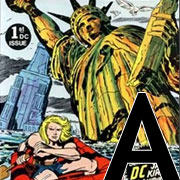 A is for Apocalypse and its Aftermath
A is for Apocalypse and its AftermathLike 70s cinema, Bronze Age comics loved the end of the world, and had an "irradiated-sky's the limit" approach to what came after. Killraven swashbuckled with Bruno-esque fashion sense through a world where Wells' War of the Worlds had really happened. The astronauts of Atlas/Seaboard's Planet of Vampires returned to a devastated, vampire-ruled earth that played like a mashup of Planet of the Apes and Omega Man. Kirby outdid Planet of the Apes in Kamandi by evolving the whole zoo above humankind after the mysterious Great Disaster. Hercules Unbound eventually was revealed to share the same post-apocalypse with Kamandi, and with the giant dalmatian riding Atomic Knights from the 60s. Cranking the apocalypse dial to "eleven," Starlin destroyed the entire Milky Way galaxy in Metamorphosis Odyssey. Compared to these outre visions, the standard nuclear holocausts of Doomsday+1, and Mighty Samson seem positively tame.
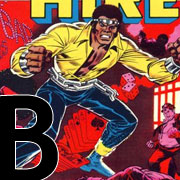 B is for Black
B is for BlackAnd probably blaxploitation. Say it loud, African American characters burst onto the scene in the 70s, and were so proud almost every one of them used "black" in their name. Sweet Christmas! Luke Cage became the first black superhero with his own title in 1972, and it was followed by the short-lived Black Goliath. DC's first African American superhero, Mal Duncan, appear in Teen Titans in 1970. In 1971, he was followed by John Stewart, who would one day be the titular Green Lantern of a series. DC didn't wind-up giving a black character a book of their own until Black Lightning (1977), but would've published the first title starring a black super-heroine with Vixen, had not the Implosion nixed it.
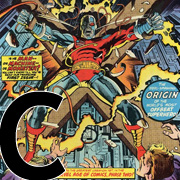 C is for corporate evil
C is for corporate evil Over-the-top corporate malevolence may be part of "the world that's coming" in Kirby's OMAC, but it also reared its Serpent Crown wearing head in the present day in the form of sinister Big Oil company, Roxxon, and anti-environment Man-Thing nemesis, F.A. Schist. The military industrial complex baddies responsible for the creation of Deathlok are no less evil for being in an alternate future. Better not to even get into the banal, faceless corporations that were dummies for perennial world conquers like HYDRA or AIM.
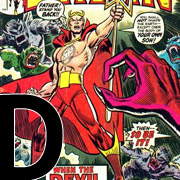 D is for Devil
D is for DevilThe Bronze Age comeback of the Prince of Lies has been chronicle in the BAS before. In addition to the satanic choir of brimstone-smelling baddies, we got the titular Demon, Etrigan, who proved that hellspawn could be heroes, too. Shuma-Gorath and his tentacled ilk brought a touch of Lovecraftian horror to the superhero proceedings, and I think we're all better for it.
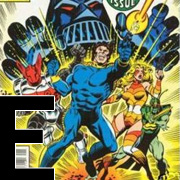 E is for Extradimensional
E is for ExtradimensionalIn the Silver Age, most "out there" characters came from another world, but in the Bronze Age more and more characters were popping in from other universes entirely. Howard the Duck and Korrek the Barbarian, were among those that dropped into Man-Thing through a heavy-traffic, Nexus of Realities in the Everglades. Shade the Changing Man came to earth from his home dimension of Meta. The Infinity Man chillaxed in an other-dimensional eden until summoned by the Forever People. The Micronauts proved there were no small heroes, only small universes.
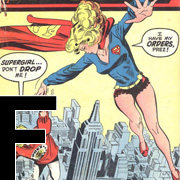 F is for feminism
F is for feminismIt's "Ms." Marvel, thank you. Not only did Carol Danvers choose a hip pro-women's lib codename in her 1977 superhero debut, but she also was the editor of Woman magazine--which one assumes was not full of housecleaning tips. Avengers #80 (1970) featured the first all-female superhero team, the Lady Liberators (though they were being duped by the Enchantress), and the 70s saw an explosion in female lead titles from Red Sonja to Supergirl. Of course, angst about gender roles was far from resolved--Thundra and her Femizons from an alternate future, were like Rush Limbaugh's worst nightmare of feminism, and the less said about the villianous militant feminist, Man-Killer, the better (really).
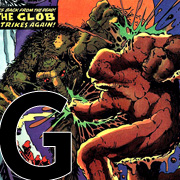 G is for Giant-Sized
G is for Giant-SizedIn the Bronze Age, size did matter. Marvel released a number of hefty, 80-page comics under this banner in the Bronze Age including the historic Giant-Sized X-Men, and the suggestive Giant-Sized Man-Thing. DC called their equivalent Dollar Comics (a reference to the price, naturally), but they were just as giant. Characters also got super-sized in the Bronze Age. Merely being a Giant Man wasn't enough anymore--what with Devil Dinosaur and Godzilla, stomping around, and the Shogun Warriors invading from space.

1 comment:
This is great! I hope you finish it! The choices are endless -- but a favor? Don't use Moondragon for M -- she is STILL my least fave Marvel character ever! ::lol:: :-)
Boox
Post a Comment